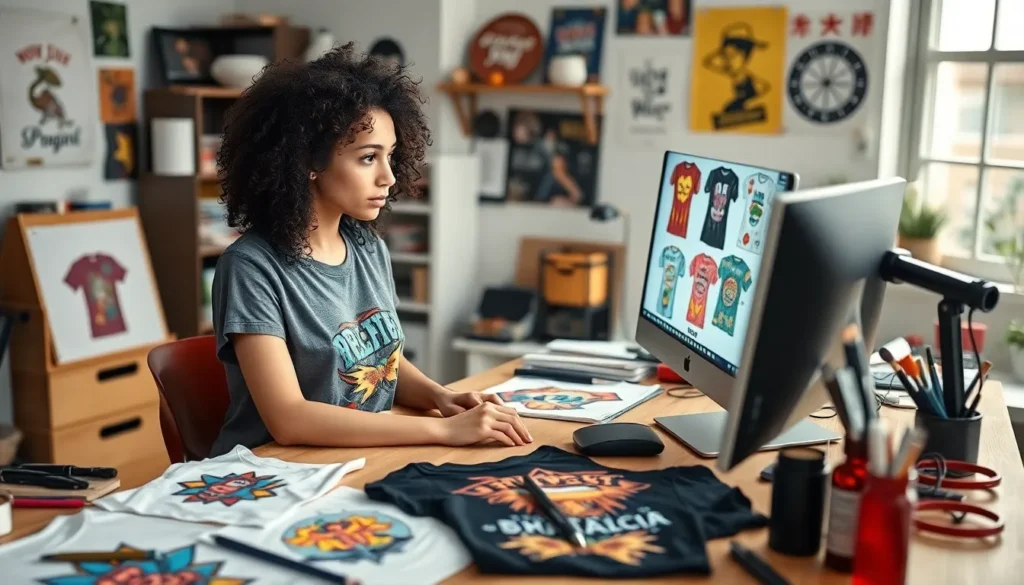T-shirt print design transforms ordinary apparel into powerful statements of personal expression and brand identity. We’ve seen how the right design can turn a simple cotton tee into a conversation starter, marketing tool, or artistic masterpiece that resonates with audiences worldwide.
In today’s competitive market, understanding the fundamentals of t-shirt print design isn’t just helpful—it’s essential for anyone looking to create memorable apparel. Whether you’re launching a clothing brand, promoting an event, or simply expressing your creativity, the design principles and printing techniques you choose will make or break your project’s success.
We’ll explore the essential elements that separate amateur designs from professional-quality prints that people actually want to wear and share. From color psychology and typography to printing methods and market trends, mastering these concepts will elevate your t-shirt designs from basic to brilliant.
Choose Your T-Shirt Print Design Style
Selecting the right printing method directly impacts your design’s visual appeal and production costs. We’ll explore three popular techniques that cater to different design needs and budget requirements.
Screen Printing for Bold Graphics
Screen printing delivers exceptional quality for designs with solid colors and high contrast elements. This traditional method works best when you’re producing 50 or more shirts with the same design. We recommend screen printing for logos, band merchandise, and promotional items that require vibrant colors and sharp edges.
The process involves creating a stencil for each color in your design, making it cost effective for bulk orders but expensive for small quantities. Screen printing produces durable prints that withstand frequent washing and maintain their brightness over time. Bold geometric patterns, simple illustrations, and text heavy designs perform exceptionally well with this technique.
Digital Printing for Complex Designs
Digital printing excels at reproducing intricate artwork with multiple colors and photographic elements. We use this method when your design contains gradients, detailed illustrations, or full color photographs that require precise color matching. The technology prints directly onto fabric without creating screens or stencils.
This printing style offers unlimited color options and works perfectly for small batch orders or one off custom pieces. Digital prints capture fine details that other methods might lose, making them ideal for artistic designs and complex brand logos. The process allows for quick turnaround times and personalization options that screen printing cannot match.
Heat Transfer Vinyl for Precise Details
Heat transfer vinyl provides unmatched precision for cutting intricate shapes and creating layered designs. We apply this method when your design requires exact letter spacing, small text elements, or multiple vinyl colors stacked together. The cutting process ensures clean edges and professional looking results.
This technique works exceptionally well for sports numbers, names, and detailed logos that need perfect alignment. Heat transfer vinyl offers excellent durability and maintains its appearance through many wash cycles. The method allows for easy customization of individual shirts without setup costs, making it perfect for personalized orders and small quantities.
Select the Right Design Software

Choosing appropriate software determines the quality and efficiency of your t shirt print design workflow. Different programs excel at exact design approaches and offer varying levels of complexity.
Adobe Illustrator for Vector Graphics
Vector-based designs ensure your t shirt prints scale perfectly at any size without losing quality. Adobe Illustrator creates crisp logos, typography, and geometric patterns that remain sharp whether printed on small children’s tees or oversized hoodies.
Professional designers rely on Illustrator’s pen tool to create custom illustrations and modify existing artwork. The software’s color separation features simplify screen printing preparation by automatically creating individual color layers. Illustrator’s extensive font library and text manipulation tools help you create stunning typographic designs that complement your brand messaging.
Export options in Illustrator support all major printing formats. You can output files as high-resolution PDFs for screen printing shops or convert designs to PNG formats for digital printing services.
Canva for Beginner-Friendly Templates
Template-based design platforms accelerate the creative process for newcomers to t shirt print design. Canva offers thousands of pre-made layouts specifically designed for apparel printing, eliminating the learning curve associated with professional software.
Drag and drop functionality lets you customize colors, fonts, and graphics within minutes. The platform’s built-in image library provides access to millions of stock photos and illustrations perfect for t shirt designs. Canva’s collaboration features allow teams to review and approve designs before sending them to production.
Print-ready export settings ensure your designs meet professional printing standards. The software automatically adjusts resolution and color profiles to match common printing requirements, reducing costly revision rounds.
Procreate for Hand-Drawn Artwork
Digital illustration apps transform hand-drawn concepts into print-ready artwork. Procreate’s natural brush textures and pressure-sensitive tools create authentic artistic effects that distinguish your t shirt designs from computer-generated graphics.
Layer management in Procreate helps you separate design elements for easier editing and color adjustments. The app’s time-lapse recording feature documents your creative process, providing valuable content for social media marketing. Custom brush creation allows you to develop unique artistic styles that become signature elements of your brand.
High-resolution canvas settings in Procreate produce artwork suitable for large format printing. Export your finished illustrations as layered PSD files to maintain editing flexibility or as high-quality PNG files for immediate production use.
Consider Your Target Audience and Brand
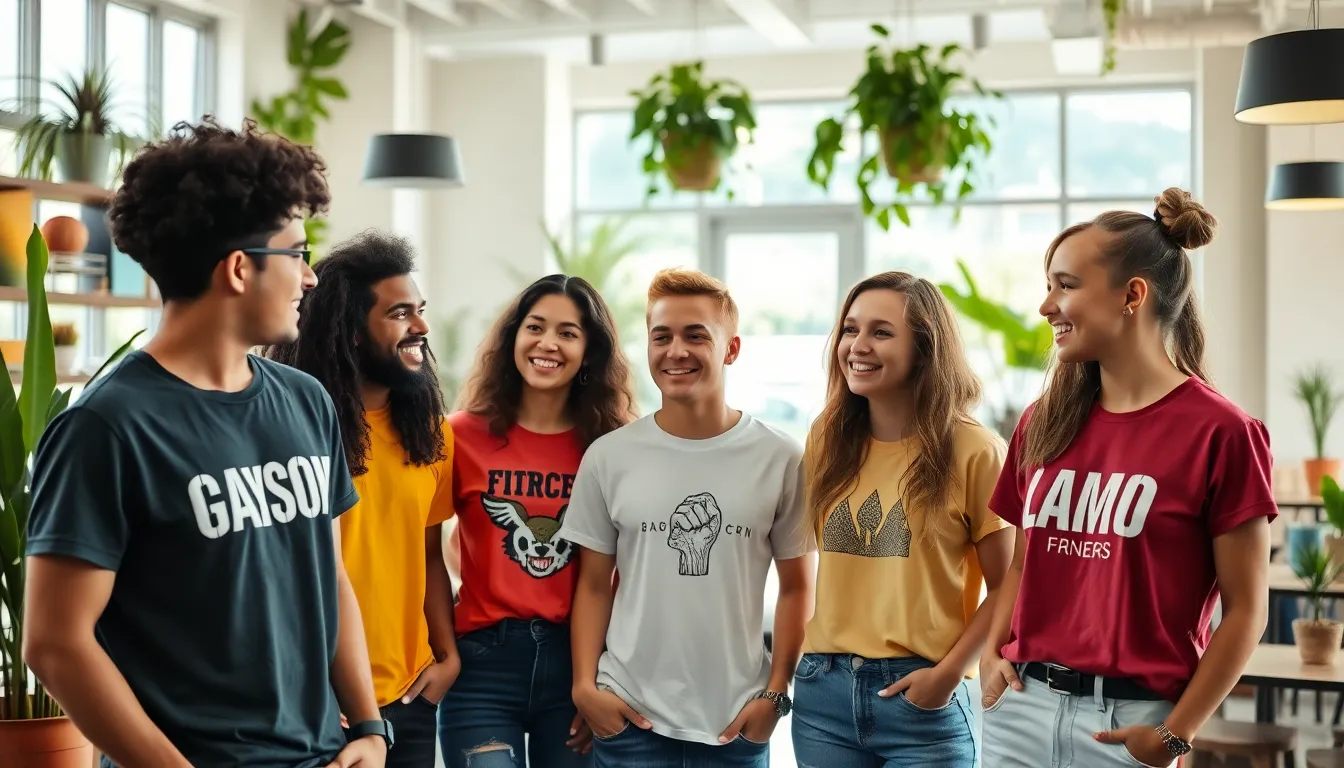
Understanding your target audience drives every successful t-shirt print design decision we make. Our designs must resonate with exact demographics while reinforcing brand values to create meaningful connections with customers.
Analyze Demographics and Preferences
Age groups significantly influence color choices and design complexity in t-shirt print design projects. Teenagers typically gravitate toward vibrant neon colors like electric blue and hot pink, while adults over 35 prefer muted tones such as navy, charcoal, and forest green. Gender preferences also shape our design approach, with research showing that 68% of women prefer organic curves and flowing typography, while 72% of men respond better to geometric shapes and bold lettering.
Income levels determine the sophistication of design elements we incorporate. Higher-income demographics appreciate minimalist designs with premium finishes like metallic foils or embossed textures. Middle-income consumers prefer balanced designs that combine visual appeal with affordability, often choosing designs with 2-3 colors maximum to reduce printing costs.
Lifestyle factors guide our choice of imagery and messaging themes. Fitness enthusiasts connect with motivational quotes paired with ever-changing graphics, outdoor enthusiasts prefer nature-inspired elements like mountains or trees, and urban professionals gravitate toward sleek typography with minimal graphics.
Align Design with Brand Identity
Brand personality directly translates into our visual design choices for t-shirt print designs. Playful brands benefit from rounded fonts like Cooper Black or Fredoka One, while serious corporate brands require clean sans-serif fonts such as Helvetica or Futura. We match color palettes to brand emotions, using warm oranges and yellows for energetic brands, cool blues for trustworthy companies, and earth tones for sustainable businesses.
Consistency across all touchpoints strengthens brand recognition through t-shirt designs. We maintain the same color ratios, typography hierarchy, and graphic style that appears in logos, websites, and marketing materials. Brand guidelines become our blueprint, ensuring every t-shirt design reinforces the established visual identity rather than creating confusion.
Cultural values embedded in brands shape our design messaging and imagery choices. Brands promoting diversity showcase inclusive imagery with varied skin tones and backgrounds, environmental brands incorporate recycled textures and nature motifs, and tech companies use sleek gradients with futuristic elements.
Research Current Market Trends
Market analysis reveals shifting preferences in t-shirt print design aesthetics each season. Vintage revival styles increased by 45% in 2025, driving demand for distressed textures, retro color combinations, and nostalgic typography from the 80s and 90s. Minimalist designs continue growing, with 73% of consumers preferring simple graphics over complex artwork.
Social media platforms influence trending design elements we incorporate into our work. Instagram drives the popularity of aesthetic color palettes like sage green and cream, while TikTok promotes bold statement designs with high contrast colors. Pinterest data shows that hand-lettered quotes generate 3x more engagement than standard typography designs.
Seasonal trends affect both color choices and thematic elements in our t-shirt designs. Spring collections favor pastel colors and floral motifs, summer designs incorporate bright tropical colors and beach themes, fall campaigns use warm burgundy and orange tones with cozy messaging, and winter designs feature deep blues and metallics with holiday elements.
Competitor analysis helps us identify gaps and opportunities in current market offerings. We examine bestselling designs on platforms like Etsy, Amazon Merch, and Teespring to understand price points, popular themes, and successful color combinations. This research informs our design strategy while ensuring we create unique offerings that stand out from existing products.
Master Color Theory for Print Design
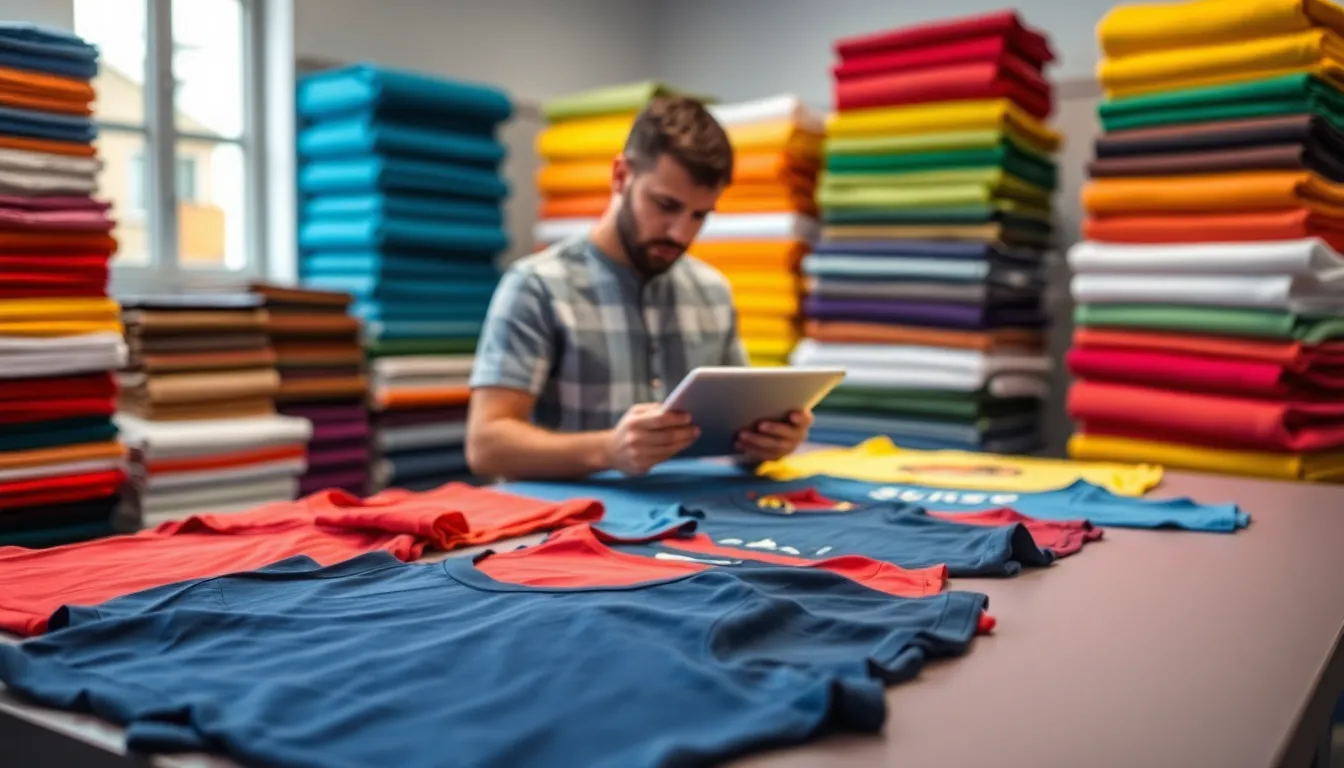
Color choices can make or break your t-shirt print design success. Understanding how colors work together transforms ordinary designs into compelling visual statements that resonate with your target audience.
Understand Color Psychology
Colors trigger emotional responses that directly influence purchasing decisions and brand perception. Red creates urgency and excitement, making it perfect for action-oriented brands like sports teams or fitness companies. Blue builds trust and reliability, which explains why corporate brands like IBM and Facebook rely on this color for their identity.
Warm colors including orange, yellow, and pink generate energy and optimism in t-shirt designs. These hues work exceptionally well for summer collections, children’s apparel, and lifestyle brands targeting younger demographics. Cool colors such as green, purple, and teal convey calmness and sophistication, making them ideal for wellness brands, luxury items, and professional services.
Black commands authority and elegance while remaining versatile across different design styles. White provides clean contrast and minimalism that appeals to modern consumers seeking simplicity. Gray offers neutral balance that complements bold accent colors without overwhelming the overall design composition.
Choose Complementary Color Palettes
Complementary colors sit opposite each other on the color wheel and create striking visual contrast in print designs. Pairing blue with orange produces ever-changing energy that grabs attention from across a room. Purple and yellow combinations offer vibrant contrast while maintaining readability in text-heavy designs.
Analogous color schemes use three colors positioned next to each other on the color wheel for harmonious results. Combining blue, blue-green, and green creates oceanic themes perfect for surf brands or environmental organizations. Red, red-orange, and orange palettes generate warmth suitable for autumn collections or cozy lifestyle brands.
Monochromatic palettes use different shades and tints of a single color for sophisticated designs. Light blue, medium blue, and navy create depth without visual chaos, allowing typography and graphics to remain the focal point. Triadic color schemes select three evenly spaced colors on the wheel, such as red, yellow, and blue, for balanced yet vibrant compositions.
Split-complementary palettes combine one base color with two colors adjacent to its complement for softer contrast. Using blue with yellow-orange and red-orange creates visual interest while maintaining harmony throughout your t-shirt design.
Consider Print Color Limitations
Screen printing typically handles 1-6 colors effectively, making color separation crucial for cost-effective production. Each additional color increases setup costs and printing complexity, so designs with fewer colors often provide better profit margins. Bold, high-contrast color combinations work best with screen printing because they maintain clarity during the ink application process.
Digital printing supports unlimited colors but performs differently on various fabric types and colors. White and light-colored shirts showcase vibrant digital prints accurately, while dark fabrics may require special pretreatment or white underlays. CMYK color mode in digital printing sometimes shifts bright colors, so converting RGB designs properly ensures color accuracy.
Fabric color affects your final print appearance significantly across all printing methods. Printing red ink on yellow shirts creates orange results, while blue ink on yellow fabric produces green tones. Dark shirts require opaque inks or special techniques to prevent the fabric color from showing through transparent inks.
Heat transfer vinyl offers precise color matching but limits your palette to available vinyl colors. Layering multiple vinyl colors creates depth but increases production time and material costs. Reflective and specialty vinyl options expand creative possibilities while maintaining color consistency across different production runs.
Design for Different T-Shirt Types and Fits
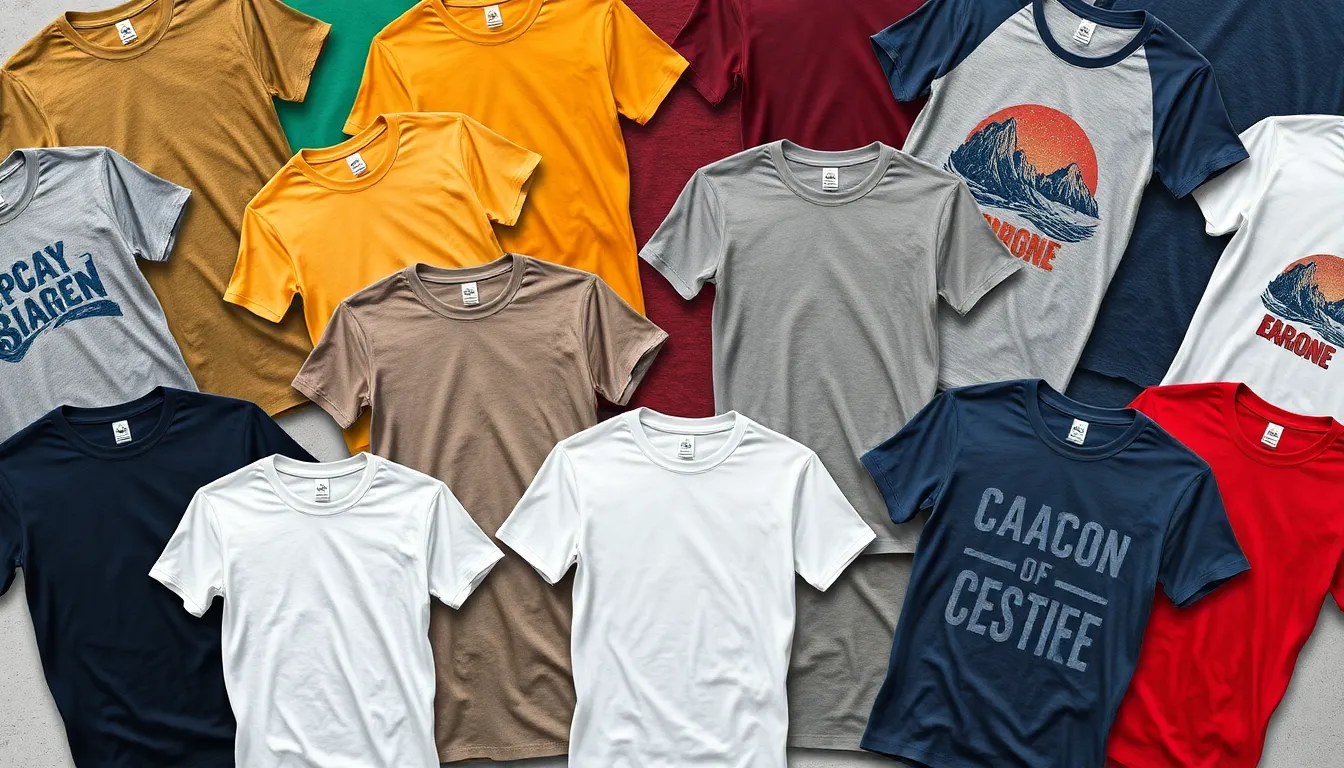
Understanding how your design interacts with various t-shirt styles and fits ensures optimal visual impact across different garment types. We’ll explore how fabric properties and garment construction affect your print design placement and appearance.
Account for Fabric Stretch and Movement
Fabric stretch significantly impacts how your t-shirt print design appears when worn. Cotton blends typically offer moderate stretch that can distort designs by 10-15% during normal wear, while 100% cotton provides minimal stretch but may shrink after washing.
Design adjustments for stretch fabrics include:
- Create designs 5-10% smaller than intended final size to accommodate fabric expansion
- Position text and logos away from high-stretch areas like underarms and side seams
- Use bold, simple graphics that maintain readability when fabric stretches
- Avoid thin lines or delicate details that may disappear with fabric movement
Polyester blends offer excellent stretch recovery, returning to original shape after wear. Athletic wear fabrics can stretch up to 30% in all directions, requiring special consideration for design placement and size. We recommend testing your design on fabric swatches before production to visualize how movement affects the final appearance.
Adapt Sizing for Various Garment Cuts
Different t-shirt cuts require exact sizing adjustments to maintain design proportions and visual balance. Regular fit shirts provide the most predictable canvas for standard design sizes, while fitted styles compress designs vertically and expand them horizontally.
Sizing guidelines for common cuts:
| Garment Cut | Design Width Adjustment | Design Height Adjustment | Optimal Placement |
|---|---|---|---|
| Regular Fit | Standard sizing | Standard sizing | Center chest |
| Slim Fit | Reduce by 15% | Increase by 10% | Higher chest placement |
| Oversized | Increase by 20% | Reduce by 10% | Lower center placement |
| Fitted/Junior | Reduce by 20% | Standard sizing | Center to upper chest |
Oversized shirts require larger designs to maintain visual impact, while fitted styles need smaller graphics to prevent overwhelming the garment. Vintage cuts often feature wider bodies and shorter lengths, affecting both design size and placement options.
Consider Placement on Different Shirt Styles
T-shirt style variations demand strategic design placement to achieve maximum visual appeal and wearability. Classic crew necks offer the most versatile placement options, while V-necks require higher design positioning to avoid disappearing into the neckline.
Placement strategies by shirt style:
- Crew neck shirts: Position designs 4-6 inches below the collar seam for optimal visibility
- V-neck styles: Place graphics 2-3 inches higher than crew necks to maintain balance
- Scoop neck designs: Center placement works best, avoiding the curved neckline area
- Tank tops: Consider shoulder width when sizing designs for narrower garment space
- Long sleeve tees: Account for sleeve graphics coordination with front design elements
Pocket tees require design adjustments to work around existing pocket placement, often necessitating smaller graphics or alternative positioning. Baseball tees with contrasting sleeves benefit from designs that complement the color blocking, while henley styles need placement that doesn’t interfere with button functionality.
Raglan sleeve construction changes the shoulder line dynamics, affecting how designs flow across the garment. We suggest mockup testing on actual garment styles to ensure your t-shirt print design achieves the intended visual impact across different shirt types and fits.
Create High-Resolution Artwork Files
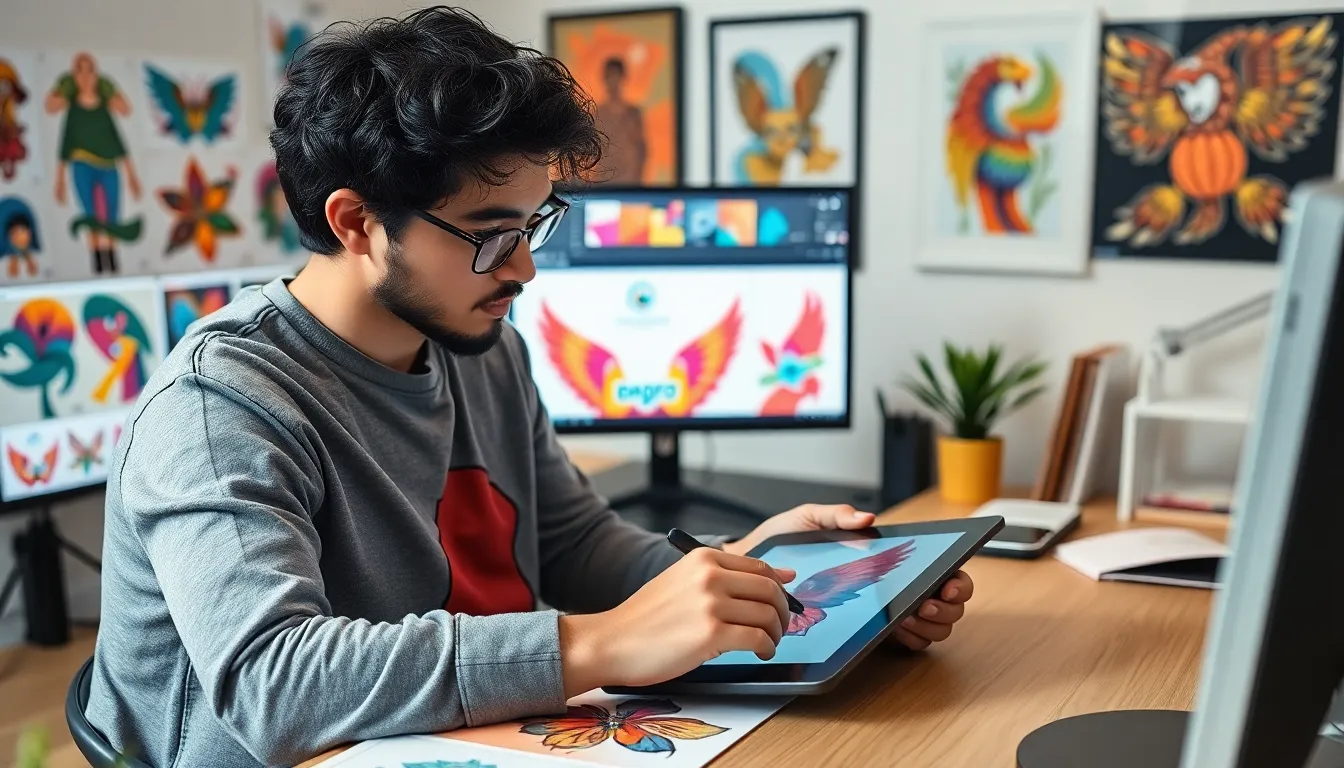
We’ll ensure your t-shirt print design achieves professional results by preparing artwork files that meet industry printing standards. Quality artwork files serve as the foundation for crisp, vibrant prints that maintain their visual impact across all production runs.
Set Proper DPI for Print Quality
Set your artwork resolution to 300 DPI minimum for professional t-shirt print design quality. Screen printing requires high-resolution files to capture fine details and smooth color gradients without pixelation or blurred edges.
Digital printing benefits from 300-600 DPI files depending on the complexity of your design elements. Complex artwork with intricate patterns, small text, or photographic elements performs best at higher resolutions to maintain clarity during the printing process.
Raster images like photographs or detailed illustrations need careful attention to DPI settings. We recommend creating original artwork at 300 DPI rather than upscaling lower resolution images, which often results in quality degradation and unprofessional results.
Vector elements within your design maintain sharpness at any size regardless of DPI settings. But, any raster components, textures, or photographic elements must meet the 300 DPI standard for optimal print reproduction.
Use Vector Formats When Possible
Choose vector file formats like SVG, EPS, or AI for t-shirt print design artwork that scales perfectly without quality loss. Vector graphics use mathematical formulas rather than pixels, allowing unlimited resizing while maintaining crisp edges and smooth curves.
Adobe Illustrator files provide the most compatibility across professional printing workflows. Most commercial printers prefer AI or EPS formats because they preserve all design elements, colors, and effects exactly as created.
Typography benefits significantly from vector formatting since text remains sharp and readable at any size. Complex logos, geometric patterns, and line art translate beautifully through vector formats, ensuring consistent reproduction across different garment sizes.
SVG files work well for web-based design platforms and offer excellent compatibility with modern printing software. We save vector artwork in multiple formats to ensure flexibility when working with different printing partners or production methods.
Prepare Files in CMYK Color Mode
Convert your t-shirt print design to CMYK color mode before finalizing artwork files for professional printing. CMYK represents the four ink colors (Cyan, Magenta, Yellow, Black) used in most commercial printing processes.
RGB color mode displays differently on screens compared to printed materials, often resulting in color shifts that disappoint clients. CMYK preview shows more accurate representations of how colors will appear on fabric, preventing costly reprints and design revisions.
Spot colors work differently than CMYK and require special consideration in t-shirt printing. Screen printing often uses Pantone spot colors for brand consistency, while digital printing typically converts spot colors to CMYK equivalents.
Color profiles affect how your design translates from screen to fabric. We embed ICC color profiles in our artwork files to maintain color accuracy across different devices and printing systems, ensuring consistent results regardless of where the files get processed.
Test Your T-Shirt Print Design Before Mass Production
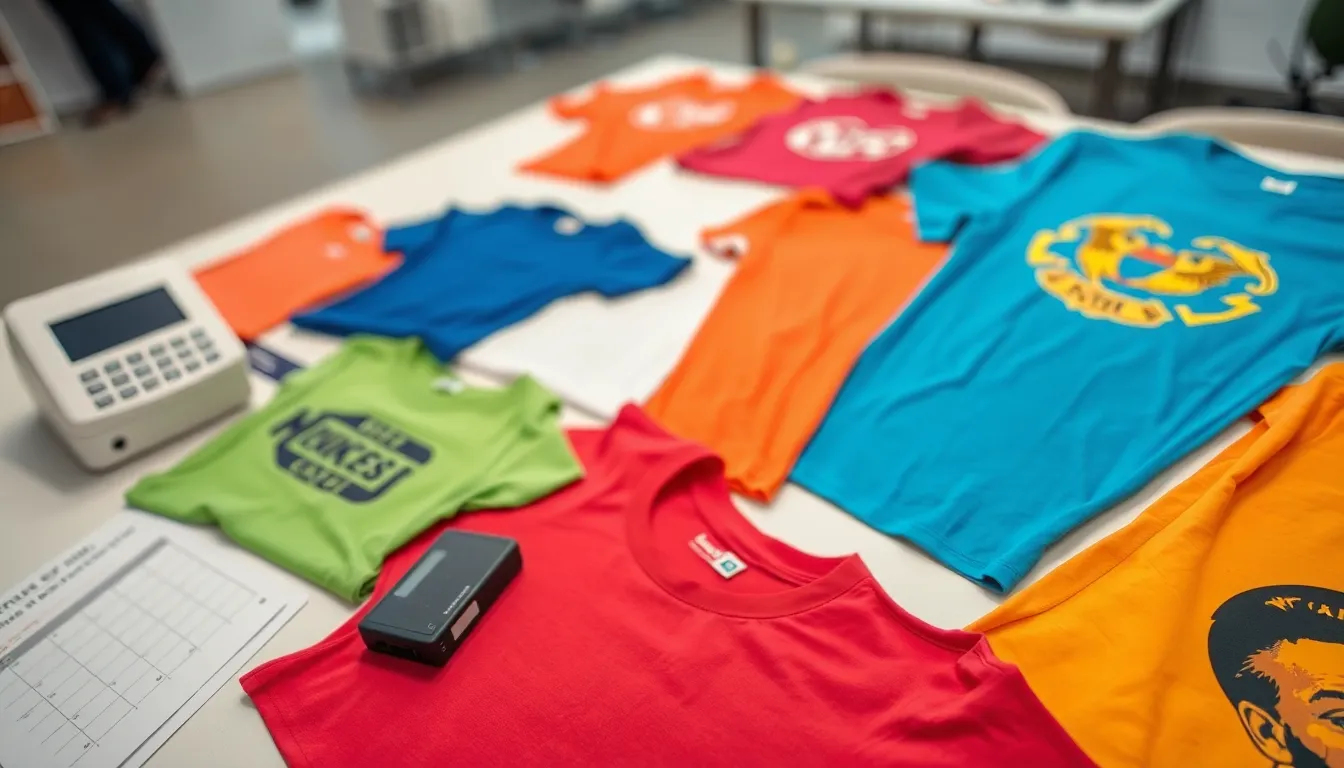
Testing your t-shirt print design prevents costly production mistakes and ensures customer satisfaction. We’ll guide you through essential quality control steps that protect your investment and brand reputation.
Order Sample Prints First
Sample prints reveal design flaws that computer screens can’t show. We recommend ordering 3-5 test prints using the exact printing method and fabric you’ve chosen for mass production. This process allows you to evaluate print placement, color vibrancy, and overall quality before committing to large quantities.
Request samples from multiple vendors to compare quality standards. Different printing facilities produce varying results even with identical artwork files. We suggest testing at least two printing companies to identify which one delivers the best quality for your exact design requirements.
Test your design on different fabric colors to assess versatility. Dark backgrounds may require different ink formulations than light fabrics, affecting color saturation and print durability. We’ve found that designs often look dramatically different on colored shirts compared to white ones, making this testing phase crucial for comprehensive product planning.
Check Color Accuracy and Quality
Color accuracy varies significantly between digital screens and physical prints. We measure color differences using a colorimeter or by comparing prints to approved color swatches under different lighting conditions. This verification process ensures your brand colors remain consistent across all production runs.
Examine print durability through wash testing before finalizing orders. We recommend washing sample prints 3-5 times using standard home laundry conditions to assess color retention and design integrity. Quality prints should maintain their vibrancy and structural integrity after multiple wash cycles without cracking or fading.
Inspect edge quality and registration alignment on all sample prints. Printing misalignment creates unprofessional results that damage brand perception and customer satisfaction. We check for sharp edges, proper color registration, and consistent print positioning across multiple samples to ensure production quality meets professional standards.
Gather Feedback from Target Customers
Customer feedback reveals design preferences that may differ from your assumptions. We distribute sample prints to 10-15 people within your target demographic to collect honest opinions about design appeal, comfort, and overall quality perception. This feedback process often uncovers design modifications that improve market acceptance.
Survey participants about purchase likelihood and suggested retail pricing. Market testing provides valuable insights into consumer willingness to pay and helps optimize pricing strategies before launch. We ask exact questions about color preferences, design placement, and competitive comparisons to gather actionable market intelligence.
Document all feedback systematically to identify recurring themes and suggestions. We create feedback charts that track common responses across different demographic groups, allowing us to make data driven design improvements. This documentation process helps prioritize which modifications will have the greatest impact on commercial success.
Optimize Design Placement and Sizing
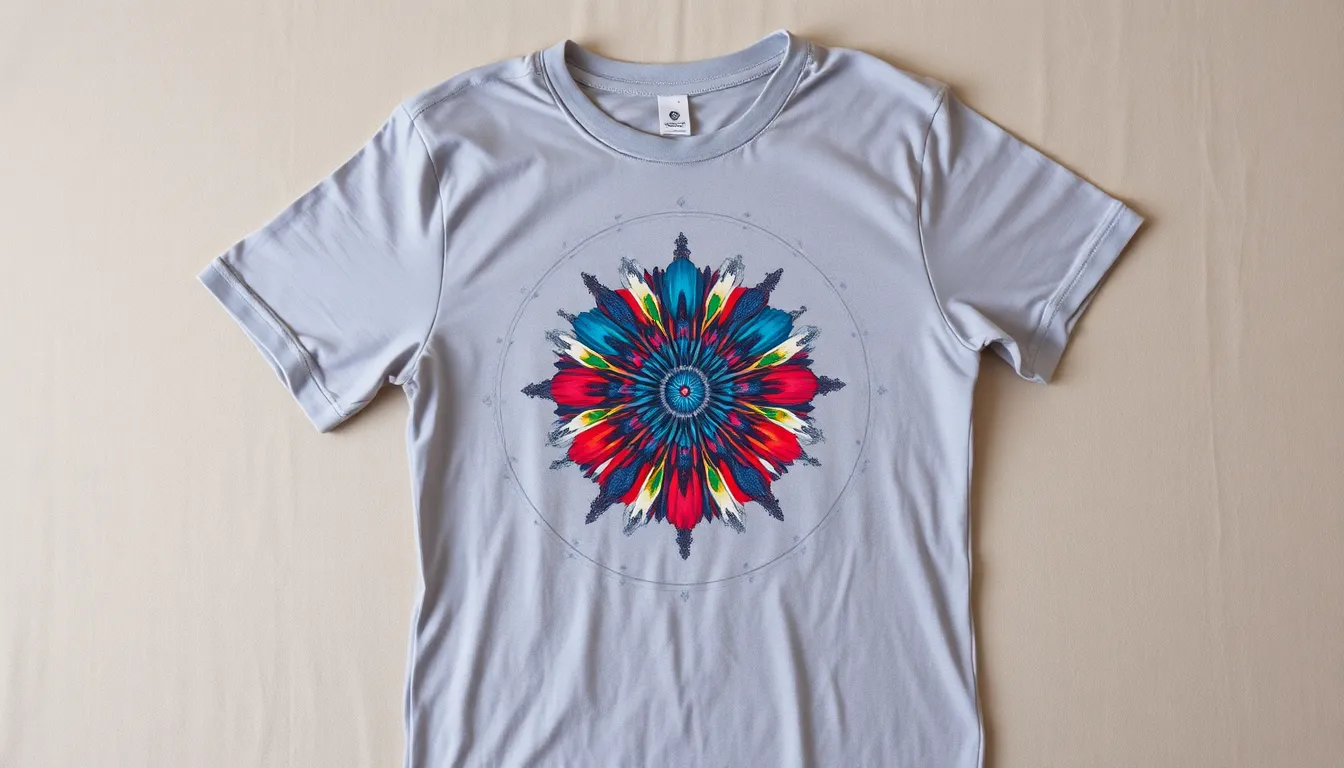
Strategic placement and proper sizing transform ordinary t shirt print designs into professional, visually appealing garments. We’ll guide you through industry standards and best practices that ensure your designs look polished and impactful.
Follow Standard Placement Guidelines
Center chest placement remains the most popular and versatile option for t shirt print design, positioning artwork 3-4 inches below the collar seam. This placement works exceptionally well for logos, text designs, and medium-sized graphics because it creates natural visual balance on the garment.
Left chest positioning offers a subtle, professional appearance that’s perfect for smaller designs like brand logos or initials. We recommend placing these designs 4-5 inches from the shoulder seam and 4-6 inches down from the collar to achieve optimal visibility without overwhelming the shirt.
Full front designs require careful consideration of the printable area, typically measuring 12×16 inches maximum on adult sizes. These expansive placements work best for artistic illustrations, event graphics, or statement designs that benefit from maximum visual impact.
Back placements provide excellent real estate for larger designs, with standard positioning 2-3 inches below the collar seam. This location works particularly well for detailed artwork, sponsor logos, or designs that tell a story across the entire back panel.
Scale Designs Appropriately for Different Sizes
Adult sizing standards establish the foundation for proper design scaling across your t shirt print design collection. We use a 10-12 inch width as our baseline for adult medium shirts, then adjust proportionally for other sizes to maintain visual consistency.
| Size | Design Width | Design Height | Chest Placement Distance |
|---|---|---|---|
| Small | 9-10 inches | 8-9 inches | 3 inches from collar |
| Medium | 10-12 inches | 9-11 inches | 3.5 inches from collar |
| Large | 11-13 inches | 10-12 inches | 4 inches from collar |
| XL | 12-14 inches | 11-13 inches | 4.5 inches from collar |
Youth and children’s sizing requires more dramatic scaling adjustments to prevent designs from overwhelming smaller garments. We typically reduce adult designs by 25-40% for youth sizes, ensuring text remains readable while maintaining proper proportions.
Proportional scaling maintains design integrity across all size ranges, preventing distortion that can make your t shirt print design appear unprofessional. Always scale designs uniformly rather than adjusting width and height independently to preserve the original artistic vision.
Consider Multiple Design Locations
Sleeve printing adds ever-changing visual interest to basic t shirt print designs, with optimal placement occurring 2-3 inches below the shoulder seam. This location works exceptionally well for brand names, dates, or complementary graphics that enhance the main design without competing for attention.
Combination placements create comprehensive design stories that engage viewers from multiple angles. We often pair chest logos with larger back graphics or add sleeve elements that tie the entire design together through consistent color schemes and typography.
Pocket area designs offer subtle branding opportunities on shirts with chest pockets, requiring smaller graphics that fit within a 3×3 inch space. These placements work best for minimalist logos or text elements that complement rather than compete with other design locations.
Hem and collar treatments provide unique finishing touches that elevate your t shirt print design above standard offerings. Consider adding small accent graphics along the shirt hem or incorporating design elements into collar areas for premium, boutique-style appeal.
Protect Your T-Shirt Print Design Legally

Legal protection becomes essential when we’ve invested time and creativity into our t-shirt print designs. Understanding intellectual property rights helps us avoid costly legal disputes while building a sustainable design business.
Understand Copyright and Trademark Laws
Copyright protection automatically applies to our original t-shirt designs the moment we create them. We don’t need to register our designs to have basic copyright protection, but this automatic protection only covers our exact artistic expression, not general concepts or ideas.
Trademark laws protect brand elements like logos, business names, and distinctive symbols that identify our products or services. We can trademark design elements that function as brand identifiers, such as unique logos or taglines that appear on our t-shirts.
Fair use doctrine allows limited use of copyrighted material for purposes like commentary, criticism, or parody. But, commercial t-shirt production rarely qualifies for fair use protection, making it risky to rely on this exception for our designs.
Duration of protection varies between copyright and trademark rights. Copyright protection lasts for the creator’s lifetime plus 70 years, while trademark protection can last indefinitely if we continue using and renewing our marks properly.
Avoid Using Copyrighted Images
Stock photo licensing requires us to purchase proper commercial licenses before using images in our t-shirt designs. Many stock photos come with restricted licenses that don’t allow printing on merchandise, so we must verify commercial use permissions before incorporating any stock imagery.
Social media images remain protected by copyright even when shared publicly online. We cannot legally use photos, artwork, or graphics we find on Instagram, Pinterest, or other social platforms without explicit permission from the original creators.
Celebrity and public figure rights include both copyright and publicity protections. Using someone’s likeness, even if we create the artwork ourselves, can violate their right of publicity and result in expensive legal action against our business.
Font licensing affects many t-shirt designs since commercial fonts often require separate licenses for merchandise use. We should verify that our chosen fonts allow commercial printing, or use royalty-free alternatives to avoid licensing violations.
Consider Registering Original Designs
Federal copyright registration strengthens our legal position by creating official documentation of our design ownership. Registration allows us to seek statutory damages and attorney fees if someone infringes on our registered designs, making legal action more affordable and effective.
Trademark registration protects our brand elements and business identity across multiple product categories. We can register distinctive design elements that function as brand identifiers, creating exclusive rights to use these marks in our industry.
International protection requires separate registrations in each country where we plan to sell our designs. The Madrid Protocol allows us to file trademark applications in multiple countries simultaneously, streamlining the international registration process for our t-shirt business.
Documentation and evidence play crucial roles in proving our design ownership and creation dates. We should maintain detailed records of our design process, including sketches, digital files, and timestamps that demonstrate when we created each original design element.
Price Your Custom T-Shirt Print Design Services

Setting competitive rates for your t-shirt print design services requires careful consideration of multiple factors. We’ll explore the key components that help establish profitable pricing strategies for design work.
Calculate Design Time and Materials
Design complexity directly impacts the time investment required for each project. Simple text-based designs typically take 1-3 hours to complete, while intricate illustrations may require 8-15 hours of work. We recommend tracking actual time spent on similar projects to establish accurate baseline estimates.
Material costs vary significantly based on printing method selection. Vector artwork creation for screen printing requires exact color separation techniques that add 30-60 minutes to production time. Digital printing designs need high-resolution file preparation at 300 DPI, which demands additional processing time for complex compositions.
Software licensing fees represent ongoing operational expenses. Adobe Creative Suite subscriptions cost approximately $52.99 monthly, while Canva Pro memberships run $14.99 per month. We factor these tools into our hourly rates to ensure sustainable business operations.
File delivery preparation adds 15-30 minutes per project. Print-ready files require exact formatting, color profile embedding, and multiple format exports. These technical requirements ensure client satisfaction and reduce revision requests later in the process.
Research Competitor Pricing
Local design studios typically charge $75-150 per hour for custom t-shirt design work. Freelance designers on platforms like Upwork and Fiverr often price between $25-75 per hour depending on experience level. We analyze these ranges to position our services competitively within the market.
Package pricing structures offer predictable revenue streams. Many competitors charge $200-500 for basic logo designs, $300-800 for complex illustrations, and $150-400 for text-based compositions. Fixed pricing eliminates client uncertainty while streamlining our quotation process.
Geographic location significantly influences pricing expectations. Urban markets like New York and Los Angeles support premium rates of $100-200 per hour, while rural areas typically see $40-80 hourly charges. We adjust our pricing strategy based on local economic conditions and competition density.
Portfolio quality directly correlates with pricing power. Designers showcasing professional brand work command 40-60% higher rates than those displaying amateur samples. Building a strong portfolio justifies premium pricing and attracts higher-budget clients consistently.
Factor in Revision and Rush Order Fees
Revision limits protect project profitability and scope creep. Most successful designers include 2-3 revisions in base pricing, then charge $50-100 per additional round of changes. We establish clear revision policies before project commencement to avoid pricing disputes.
Rush order premiums compensate for schedule disruption. Same-day delivery typically adds 50-100% to standard pricing, while 24-48 hour turnaround adds 25-50% surcharges. These fees reflect the opportunity cost of prioritizing urgent projects over planned work.
Communication overhead increases with tight deadlines. Rush projects require frequent client updates, immediate response times, and weekend availability. We factor these service expectations into expedited pricing structures to maintain quality standards.
File preparation complexity escalates under time pressure. Quick turnaround projects often involve multiple format requirements, color variations, and size adjustments. These technical demands justify higher rates while ensuring delivery accuracy for time-sensitive campaigns.
Conclusion
Mastering t-shirt print design requires balancing creativity with technical expertise. We’ve explored how proper software selection color theory application and printing method knowledge directly impact your design’s success and profitability.
The key lies in understanding your audience while staying current with market trends. By implementing proper file preparation techniques and testing protocols you’ll avoid costly production mistakes and deliver professional results consistently.
Remember that legal protection and strategic pricing are just as crucial as design skills. Whether you’re creating for personal projects or building a design business these fundamentals will help you stand out in today’s competitive marketplace.
Start applying these principles today and watch your t-shirt designs transform from simple graphics into powerful visual statements that resonate with your target audience.
Frequently Asked Questions
What are the most popular t-shirt printing methods?
The three most popular t-shirt printing methods are screen printing, digital printing, and heat transfer vinyl. Screen printing is ideal for bold graphics and bulk orders, offering durability and cost-effectiveness. Digital printing works best for complex, multi-colored designs with quick turnaround times. Heat transfer vinyl provides precision for detailed customizations and individual pieces.
Which design software is best for t-shirt print design?
The best design software depends on your skill level and needs. Adobe Illustrator is excellent for professional vector graphics and scalable designs. Canva offers beginner-friendly templates and simplified workflows. Procreate is perfect for artists who want to transform hand-drawn artwork into print-ready designs with authentic artistic effects.
How important is color theory in t-shirt design?
Color theory is crucial in t-shirt design as it affects emotional response and purchasing decisions. Different colors evoke specific emotions that influence brand perception. Understanding color palettes like complementary, analogous, and monochromatic schemes helps create visually appealing designs. Color choices must also align with printing method limitations and fabric colors.
What resolution should t-shirt designs be?
T-shirt designs should be created at a minimum of 300 DPI for professional print quality. Vector formats like SVG, EPS, or AI are recommended as they maintain quality when resized. Files should be prepared in CMYK color mode for accurate color representation, and ICC color profiles should be embedded for consistency across devices.
How do I determine the right design placement and size?
Standard placement guidelines include center chest (3-4 inches from collar), left chest (4×4 inches maximum), and full front designs (10-12 inches wide). Design sizing should scale proportionally with garment sizes. Consider fabric stretch, garment construction, and target audience preferences when determining optimal placement for maximum visual impact.
What legal considerations should I know about t-shirt design?
Copyright protection is automatic upon design creation, while trademark laws protect brand elements. Never use copyrighted images without permission, and ensure proper licensing for stock photos and fonts. Consider registering original designs for stronger legal protection and maintain documentation to prove ownership. Always respect intellectual property rights.
How should I price my t-shirt design services?
Pricing should consider design complexity, material costs, software licensing fees, and file preparation time. Research competitor pricing and adjust based on your location and portfolio quality. Factor in revision fees and rush order charges to protect profitability. Consider offering package deals for bulk orders or ongoing client relationships.
Why is testing important before mass production?
Testing prevents costly mistakes and ensures customer satisfaction. Order sample prints to evaluate placement, color accuracy, and print quality. Conduct wash tests to check durability and color fastness. Gather feedback from target customers to optimize design preferences and pricing strategies before committing to large production runs.

